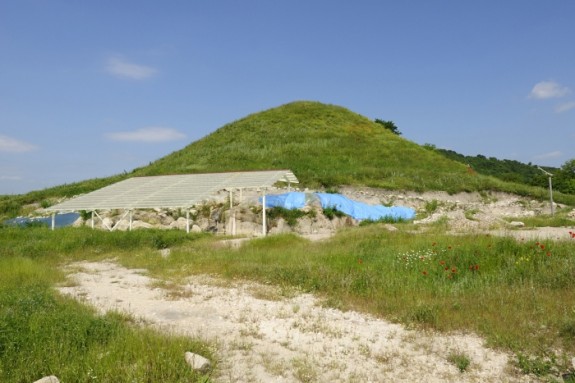Newly Uncovered, 6,500-Year-Old Fortified Stone City the Oldest in Europe
This 350-person town is the oldest of its type found to date

The stone age city lies just under this hill. Photo: Bulgarian Academy of Sciences Institute of History
A few weeks ago, we brought you the story of the massive 5,000-year old stone temple complex at the Ness of Brodgar in Scotland. That find, said researchers working on the excavation to The Guardian, was “a Neolithic treasure that utterly eclipses all others on Orkney – and in the rest of Europe.”
Not to be outdone, archaeologists working in Bulgaria have found “the oldest prehistoric town found to date in Europe,” says the BBC, a fortified stone settlement known as Provadia-Solnitsata that harks back a whopping 6,500 years, plus or minus a few centuries. This new find pre-dates the Ness of Brodgar, the pyramids, Stonehenge and the ancient Greeks by more than a millenium. It’s not the oldest stone construction in existence, not by a long shot, but the stone-walled city, thought to have been able to house around 350 people, is unique to the region.
The BBC:
Excavations at the site, beginning in 2005, have also uncovered the remains of two-storey houses, a series of pits used for rituals, as well as parts of a gate and bastion structures.
A small necropolis, or burial ground, was discovered at the site earlier this year and is still being studied by archaeologists.
The BBC says that the presence of the ancient city “almost certainly explains the treasure found exactly 40 years ago at a cemetery on the outskirts of Varna, 35km (21 miles) away, the oldest hoard of gold objects found anywhere in the world.” That collection is partially on display at the Varna Museum of Archaeology, if you’re ever in the area.
More from Smithsonian.com:
Pirate Vampire Dug Up in Bulgaria
Archaeologists Uncover Massive Stone Age Complex in Scotland
/https://tf-cmsv2-smithsonianmag-media.s3.amazonaws.com/accounts/headshot/smartnews-colin-schultz-240.jpg)
/https://tf-cmsv2-smithsonianmag-media.s3.amazonaws.com/accounts/headshot/smartnews-colin-schultz-240.jpg)